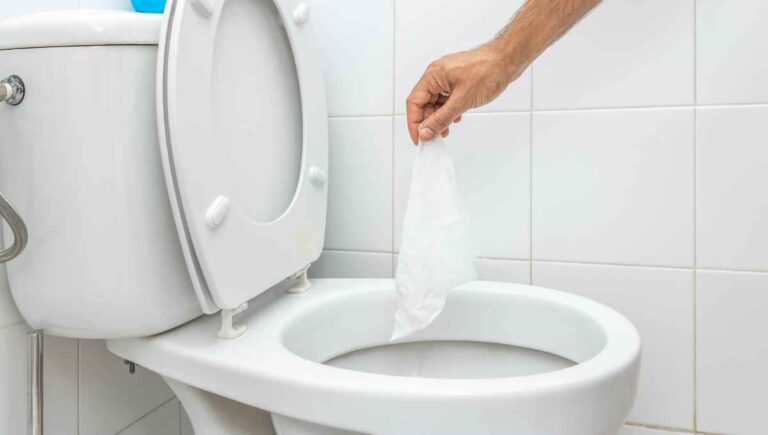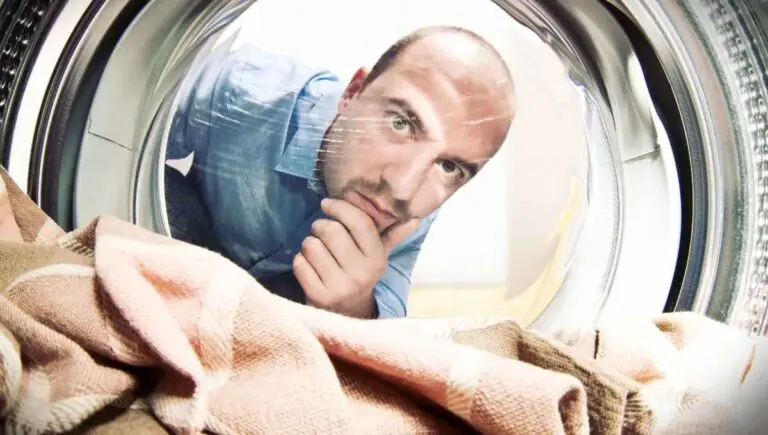Should You Leave a Shower Curtain Open or Closed? (Advice)

Shower curtains can serve many purposes, from providing privacy to keeping water from splashing onto the bathroom floor. But one question that often arises is whether you should leave the shower curtain open or closed after you’ve finished showering.
You should always leave your shower curtain closed and as stretched out as possible, especially the liner. This will help your curtain dry quickly and prevent mold from growing in the closed folds of the liner due to water getting trapped.
Mold growth isn’t a pleasant thought for your bathroom. In this article, we’ll discuss the best ways to prevent mold and mildew growth and share plenty of ways to keep your bathroom clean and mold-free!
This post contains affiliate links. This means Household Blogger may earn a commission should you make a purchase using any of our links. Please refer to our full affiliate disclosure policy for full details.
Here’s a Quick Pro Tip!
Leaving your shower curtain stretched open allows the water to drip off and evaporate quickly. However, failure to leave the curtain open may lead to mold and mildew concerns, and no one wants that.
Consider using one of these great products after your next shower to combat mold and mildew issues before they have a chance to take root:
1. Mold Inhibitor – Treat your bathtub daily to prevent fungal growth.
2. Vinegar – Prevents mold, no chemicals necessary!
3. Dehumidifier – Get rid of the excess moisture in the air quickly to prevent mold growth.
Shower Curtain Concerns
Mold and mildew issues are a big concern for everyone. You want your bathroom to be clean and orderly, and mold has no space there. This leads to many concerns about keeping your shower curtains clean. We’re talking about the best ways to do that right now!
What Do You Do With the Shower Curtain After Showering?
After you’ve showered, you should leave your shower curtain closed and as stretched out as possible. Having the shower curtain as flat as possible reduces the number of crevices where water may get trapped, reducing the likelihood of mold growth.
If your curtain has a liner, it should also be spread out as far as possible. Keeping the curtains closed and your bathroom exhaust vent running for at least an hour after a bath or shower helps reduce the air’s moisture and prevent mold growth.
How Do I Keep My Shower Curtain From Getting Mildew?
There are two easy ways to keep your shower curtain from getting mildew. The first is to ensure that you always leave your shower curtain closed after a shower so that the water dries quickly.
The second is to use a mildew-prevention spray after showering. These sprays help reduce the amount of water left on your shower curtains after a shower, preventing the formation of mildew on the curtain and liner.
Should You Close or Leave the Shower Curtain Open When Not in Use?
After showering, you should leave your shower curtain closed and stretched across the tub or shower to help it dry quickly and prevent mold and mildew. Once completely dry, you can leave it closed or open, whichever you find most aesthetically pleasing.
Leaving your shower curtain closed after a shower helps it to dry evenly and prevents water from being trapped in the creases of the bunched-up curtain. However, leaving that water to sit may result in mold and mildew. Yuck!
How Far off the Floor Should Shower Curtains Hang?
When not in use, your shower curtain should sit only an inch off the floor. However, if your curtain also has a liner, it should fit inside the tub, not outside it. This means the liner may be shorter than the curtain itself.
Shower curtains should not touch the floor of your bathroom. Keeping them off the floor keeps them cleaner and can actually help prevent mold and mildew, as it prevents trapping water between the floor and the curtain.
Does the Shower Curtain Go Inside the Bathtub?
If you are showering or are allowing your shower curtain to dry post-shower time, your shower curtain should remain inside the bathtub. Having the curtain inside the tub prevents water from dripping on your floor as it drains off of the curtain.
While you may like the look of an open shower curtain hanging outside the tub, it’s in your floor’s best interest to keep a wet curtain inside the bathtub. Even if you have a bath mat down, water may pool, which can quickly become dangerous!
Keeping It Clean and Dry
Nobody wants to deal with pools of water coming off of a shower curtain after taking a shower. Of course, keeping the curtain inside the tub helps, but what else can we do to keep our bathroom clean, dry, and mold and mildew free? Let’s talk about it.
How Do I Keep My Shower Dry?
The best, quickest, and easiest way to keep a shower dry is to run your bathroom ventilation system before, during, and at least half an hour after a shower or bath. This helps remove the hot, moist air from your bathroom, allowing it to dry out more quickly.
If you still find high moisture levels in your bathroom, consider opening a window, if possible. If your bathroom does not have an exterior window, use a dehumidifier to reduce the humidity.
What Is the Best Way to Clean a Shower Curtain Liner?
Did you know that most shower curtains and liners are machine washable? Consider adding your liner to your laundry (by itself!) next time you’re doing the wash. Wash it on a handwash or delicate cycle with a small amount of detergent on the largest load cycle.
Once your liner has gone through the wash, re-hang it and leave it closed, and stretch out the length of the tub to allow it to dry completely. We do not recommend using your clothes dryer to dry the liner more quickly, as most liners are made from plastic and will melt when exposed to high heat.
Can I Wash My Shower Curtain in the Washing Machine?
Both your shower curtain and your curtain liner are machine washable. Wash them on a delicate or handwash cycle alone, on the largest load setting. You can also add a small amount of laundry detergent.
Do not use your clothes dryer to dry your shower curtain, however. Most curtains have some level of plastic in them, and exposing them to the heat of your dryer may cause them to melt. Instead, hang them to dry naturally.
How Often Should You Clean Shower Curtains?
You should run your shower curtain through the wash at least once a month to prevent mold and mildew growth. Wash them with detergent on your washing machine’s gentle cycle for best results.
Washing your shower curtain can help prevent mold and mildew, but it also extends the life of the curtain, as mold and mildew can break plastic down quickly.
Why Does My Shower Curtain Get Moldy So Fast?
If you’re not cleaning and drying your shower curtain properly after a shower, you’ll notice mold growth quickly. Mold and mildew thrive in moist, hot climates, exactly like your bathroom.
You can combat the mold by drying out your shower curtain after use. You may also want to spray a mold inhibitor inside your tub as part of your daily cleaning routine. Lastly, washing your shower curtain at least once a month helps ensure its longevity.
Mold and Mildew Concerns
If you’re noticing yellow, orange, pink, or even black spots in your tub, I have bad news for you. It’s probably mold and mildew. Gross! No one wants to deal with that, so let’s talk about cleaning and preventing it.
Why Is My Shower Curtain Turning Yellow?
If your shower curtain is turning yellow, it may be due to old age. Most plastics become yellow over time. Unfortunately, if the curtain isn’t that old, it may be turning yellow due to the presence of mold.
Mildew, mold, and soap scum are the three biggest reasons your shower curtain may now have a yellow tinge. The best way to prevent and treat this discoloration is to use a preventative spray after you shower.
Why Do Shower Curtains Turn Pink?
A shower curtain turning pink is a sure sign of the beginning stages of mold and mildew. You may think mold can only be black, but soap scum and shower mold are often pink, orange, or yellow.
Clean your shower curtain and tub often to prevent this mold from growing. If you start to notice discoloration, immediately scrub your tub with bleach or a soap scum cleaner to kill off the mold.
Will Vinegar Remove Mold From a Shower Curtain?
If bleach and other harsh chemicals aren’t your thing, you can use vinegar to remove the mold from your shower curtain. You can even place vinegar in a spray bottle and mist your curtains to prevent mold growth.
Preventing and removing mold is an important part of a cleaning routine. For example, it’s recommended that you use vinegar or another mold inhibitor daily after showering to ensure that your bathtub doesn’t accidentally become a home for mold and mildew.
Can You Wash a Moldy Shower Curtain?
If you’ve noticed mold or soap scum in your shower curtain but can’t bear to throw it away, try washing it in your washing machine. As long as you wash it on a gentle cycle, it will not be harmed.
Once you’ve put your shower curtain through the washing machine, you should not see any residual mold or soap scum. If, however, there are still spots, you may need to scrub them individually to remove the stains fully.
What Is the Difference Between Mold and Mildew?
While both mold and mildew are considered fungi, they do have some major and important differences. The biggest difference is that mildew is usually a light film and isn’t considered harmful.
Mold, on the other hand, is typically considered dangerous, especially black mold. While both mold and mildew are bad for you, mold will continue to grow and may make you ill if inhaled over time.
You might also enjoy our post on Can I Use a Shower Curtain Without a Liner?
Replacements
Shower curtains can only last so long. In this section, we’ll discuss how often you should replace your shower curtains and liners to avoid dangerous mold and mildew. We’ll also talk about what else you can do if you don’t have a shower curtain.
How Long Do Shower Curtains Last?
Shower curtains have an unfortunately short life span. Most people find that they need to replace their shower curtains every six months to a year at most. However, you can extend the life of your shower curtain by maintaining it properly and allowing it to dry completely after a shower.
Luckily, finding a replacement for your shower curtain and liner is as easy as searching online. These days, you don’t have to settle for a boring white curtain either. How about a dinosaur or maybe some llamas?
How Often Should You Replace My Shower Curtain Liner?
As with your shower curtain, the liner will need to be replaced every six months. While washing and using mold preventatives on your shower curtain may extend its life somewhat, it will need replacement by the one-year mark.
Due to the humidity that naturally occurs within your bathroom, the curtains will only last so long. To get the most out of your shower curtain liner, be sure to clean it regularly with soap scum cleaner or vinegar to prevent mold.
What Can I Use Instead of a Shower Curtain?
If you’re renovating your bathroom, you have plenty of options to use instead of a plastic shower curtain. Consider building a sliding glass door into a walk-in shower, for example.
You can also repurpose fabric and make your own DIY shower curtain if you don’t want to purchase a cheap plastic one. Plus, it’ll be machine washable and easy to maintain once made.
Can You Shower Without a Shower Curtain?
Depending on your bathroom and shower style, it is possible to shower without the shower curtain. One option is just to use a clear liner instead of a separate shower curtain, though they don’t provide the same privacy as curtains.
A more complex but still workable solution is to utilize a movable showerhead during your shower. That way, you don’t have to have a curtain to block the water and don’t have to renovate the entire bathroom.
You might also enjoy our post on Can You Put a Shower Curtain in the Washer?
Related Questions
Should You Leave the Bathroom Door Open After a Shower?
After a shower, leave your bathroom door open and your shower curtain closed to facilitate the transfer of air and encourage the curtain to dry completely. You can also leave your bathroom’s ventilation on.
The best and easiest way to prevent mold and mildew growth is to regulate the air within your bathroom as soon as possible after a shower. You want to replace the hot, moist air from your shower with ambient, dry air as soon as possible.
How Do I Stop Condensation in My Bathroom?
Combat bathroom condensation by leaving your bathroom’s ventilation fan on for at least twenty minutes after a shower. If your bathroom doesn’t have a vent, open a window or a door instead.
No matter how you go about refreshing the air in your bathroom, removing the humid air is the most important part. If you don’t have a ventilation fan, consider using a dehumidifier instead.
Why Should You Close the Bathroom Door While You Shower?
Closing the bathroom door and turning on the ventilation is the best way to keep the humidity and heat inside your bathroom. It also prevents the warm air from escaping into the rest of your home.
Having the ability to vent out the moist air helps prevent mold and mildew growth in the rest of your home. If you cannot use a vent in your bathroom, open a window or utilize a dehumidifier instead.
Final Thoughts
A shower should be a time to relax and unwind, but mold and mildew concerns can make that difficult. We hope that these tips help you the next time you’re thinking about how to keep your shower clean and dry. Remember, when in doubt, leave the curtain stretched out!












